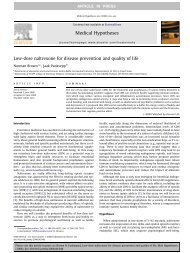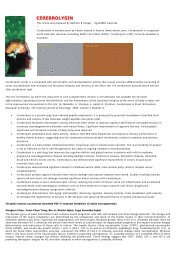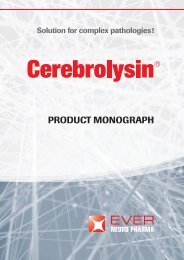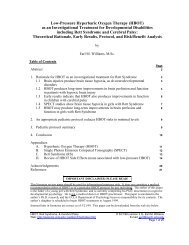Textbook of Hyperbaric Medicine - HyperMED
Textbook of Hyperbaric Medicine - HyperMED
Textbook of Hyperbaric Medicine - HyperMED
Create successful ePaper yourself
Turn your PDF publications into a flip-book with our unique Google optimized e-Paper software.
XI<br />
be assisted by the presence <strong>of</strong> oxygen. This obviously<br />
should be the case when hyperbaric treatment counteracts<br />
on oxygen deficiency. Many injuries involve the destruction<br />
<strong>of</strong> capillaries, the means <strong>of</strong> delivering oxygen. Under such<br />
circumstances, healing is itself tied to revascularization <strong>of</strong><br />
the damaged tissue. But growth <strong>of</strong> the requisite capillaries<br />
is in turn tied to the oxygen supply. This relationship can<br />
explain why in the case <strong>of</strong> many slow healing wounds, HBO<br />
seems to have a strong positive effect. Very much more can<br />
and should be done to extend the study <strong>of</strong> the speed <strong>of</strong><br />
healing to the more normal cases.<br />
In the human body, 20 percent <strong>of</strong> the oxygen consumption<br />
occurs in 3 percent <strong>of</strong> the body mass: the brain. This<br />
is also the region most sensitive to a deficiency <strong>of</strong> oxygen,<br />
which can produce dramatic results. Indeed, surgical methods<br />
on the carotid artery are <strong>of</strong>ten used to relieve oxygen<br />
deficiency to the brain. It seems logical that in HBO we<br />
have a tool that can serve a similar purpose. This might be<br />
particularly important in the case <strong>of</strong> stroke, a high-ranking<br />
cause <strong>of</strong> death and disability. It is clearly worthwhile to explore<br />
whether and to what extent disability can be reduced<br />
or avoided by prompt use <strong>of</strong> hyperbaric treatment. If the<br />
blood supply to a small region <strong>of</strong> the brain is reduced, relief<br />
might come from the diffusion <strong>of</strong> oxygen into the ischemic<br />
region from neighboring capillaries.<br />
For all new medical techniques, scientific evidence is demanded.<br />
Yet medicine is still partly an art, as well as a dramatically<br />
advancing science. Therefore in the complicated<br />
questions <strong>of</strong> life, disease, and recovery, it is sometimes hard<br />
to distinguish between the fight against the causes <strong>of</strong> a disease,<br />
and our efforts to aid toward the reassertion <strong>of</strong> overall<br />
health. There are good indications that HBO is helpful in<br />
many diseases, such as multiple sclerosis and osteomyelitis.<br />
One may mention these two applications because, in the<br />
former, earlier recognition <strong>of</strong> the disease made possible by<br />
the use <strong>of</strong> magnetic resonance imaging has made early<br />
treatment a better possibility, and seems to have given a real<br />
chance for help from HBO. In the latter case, osteomyelitis,<br />
the location <strong>of</strong> the disease is the bone, where oxygen is usually<br />
not amply available.<br />
As members <strong>of</strong> the scientific community we are all naturally<br />
tempted to theorize, as long as a glimmer <strong>of</strong> a theory<br />
might be perceived. This book proceeds, however, along<br />
strictly step by step empirical lines. Case after case, the various<br />
pathologies are reviewed. In each situation, it is carefully<br />
stated to what extent the evidence merely indicates a<br />
conclusion, and to what extent the conclusion can be<br />
proved. In the present stage <strong>of</strong> HBO, it is a certainty that<br />
there will be considerable criticism. On the other hand,<br />
those who disagree are likely at the same time to disagree<br />
among themselves. I believe that the result will be not only<br />
critical reflection, but also more experimentation, more reviews,<br />
more understanding, and more progress. It is not<br />
entirely impossible that, perhaps sometimes in the next decade,<br />
pr<strong>of</strong>essors <strong>of</strong> medicine will have difficulty in explaining<br />
why the treatment with oxygen was not widely adopted<br />
much earlier.









